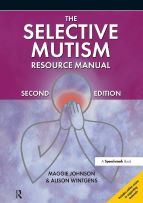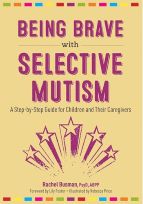
What is Selective Mutism?
A severe anxiety disorder which means a child is unable to speak freely in certain situations, often at school or in public. This is despite being able to speak freely in other situations, such as with family at home.
Selective Mutism is different to shyness; shy children may be uncertain about speaking but gradually gain confidence. Neither is Selective Mutism control or a choice – a child could not maintain their mutism for its intensity or persistence.
Creating a supportive school environment where all staff have an understanding of Selective Mutism is key to minimising anxiety and helping children to make progress.
What to look for:
Many children with Selective Mutism show anxiety beyond talking. This may include:
· Avoiding eye contact – as eye contact is often given to a child as an ‘invitation to speak’.
· Blank or fixed facial expressions – which can appear as defiance, disinterest or smirking.
· Physical tension; difficulties using non-verbal communication such as pointing or waving.
· Likewise, difficulties joining in with practical activities or PE.
· Difficulties eating at school.
· Difficulties using the toilet at school.
· Difficulty initiating any form of interaction.
· Hypervigilance.
· Doing the wrong thing or doing nothing – as anxiety impacts on the ability to process and remember information.
Children do not have to be completely silent to meet the diagnostic criteria for Selective Mutism.
Top Tips
10 Top Tips for Settings to minimise anxiety:
(Ensure that all staff know how to support the child’s communication. This includes receptionists, supply teachers, lunchtime staff and any other adults who work in school.)
Maintain a rewarding and accepting atmosphere where the child feels valued, regardless of any talking. Warmly respond to the child’s attempts to communicate non-verbally, by talking back naturally as if they had spoken.
Include the child in all activities. Provide opportunities for them to speak but do not demand it. For example, allow alternative means of communication, such as a smile, nod, look, thumbs up or raised hand, to answer the register. Likewise, provide visual representations of choices available so they can tell you or show you. Offer these to all children, not just the child in question.
Talk to the child without expecting a verbal response, e.g. “it’s nice to see you”, “you look like you had fun at breaktime”, “come in and see what activity you’d like to try”, etc. You could also make comments which may provoke a response but do not require one, e.g. “I wonder…”, “it looks as though…”, “I expect…”, “that looks like your dog but I can’t remember his name”, etc.
Avoid asking the child direct questions that require a spoken answer, so that they do not feel pressured to talk. They are unlikely to be able to answer, which will strengthen their fear and make it harder for them to answer in the future. Reassure the child in private that you won’t single them out to answer a question or read aloud unless they let you know that they want to be chosen.
Only ask questions that allow the child to respond non-verbally, for example, “show me which one you like best” and “whose turn now?” (allowing them to point to themselves or the adult). If you inadvertently ask a direct question, answer it yourself or sidestep – e.g. “let’s decide later”.
Avoid the dread of turn-taking in circle-time or whole-class activities by asking who would like to say something, rather than waiting for each child to have a go.
Praise the child’s non-verbal achievements and positive behaviours, e.g. “good sharing”, “you look smart today” or “you’ve written your name very neatly”. Notice when they are being helpful, kind, brave, hard-working, etc.
Encourage independence and success by setting small achievable targets with the child. Help them think of things they can do for themselves, e.g. showing a new child where to put their bag, or helping a less able child to tidy up.
Ensure the child can access the toilet, drinks, help and First Aid without speaking. Agree a procedure for when they feel ill. Invite them to let you know if anything is upsetting them.
If the child does talk, do not overreact or draw attention to it. Instead focus on what they conveyed rather than the fact that they spoke, and respond as you would any other child.
10 Top Tips for Parents and Carers:
Talk to your child openly about their speech anxiety. Explain that you know it is frightening for him or her to talk in school, and lots of children feel this way. Say that it will not last and they will feel better about talking.
Ensure that your child sees themselves as someone who has not spoken in certain situations yet, rather than a non-speaker.
Try to avoid labelling your child as shy. Children with Selective Mutism are typically sensitive, but being told they are ‘shy’ or ‘don’t talk’ can maintain their difficulties.
Avoid unwillingly putting pressure on your child in the following ways:
gentle persuasion – “just have a little go, it’s easy”
cajoling – “just whisper then”
incentives, bribery – “if you say your name, you can have a special sticker”
reprimands – “your teacher can’t help you if you don’t her what’s wrong”
disapproval – “are you finally going to talk to your auntie / teacher today?”
ignoring – “it’s fine, you can talk to them just like you talk to us at home”
joining in – “it makes me sad when you don’t talk to your friends”
Instead you could try:
“everyone feels a bit nervous sometimes… it’s okay, you can still have a good time”
“I think you will do some really fun things today”
“show me what you would like to play with”
“let’s think of the best way for you to join in”
Likewise, do not tell your child to ‘say thank you’ or otherwise, as this puts them under direct pressure. Instead model saying ‘thank you’ yourself, and encourage your child to use their non-verbal communication skills such as smiles and waves.
Try not to spring surprises on your child; prepare them for changes and transitions.
Limit choices – too many choices when we are anxious can make us more stressed. Children with Selective Mutism often want to ‘get it right’, even if there is no obvious correct answer. Give clear alternatives, e.g. a stated choice of two options.
Provide your child with the opportunity to play, communicate and share activities with other children outside of school hours, including texting or emailing if appropriate.
Ensure that any concerns about your child are not discussed in front of them.
Seek to address any additional social, emotional or mental health needs that your child may have, for example via your GP, health visitor, school nurse or BeeU: https://www.mpft.nhs.uk/services/camhs/beeu
Addressing underlying difficulties related to anxiety will help your child to make subsequent progress with their talking.
Selective Mutism Video
Our 'Supporting Children with Selective Mutism' video is available for parents, carers and professionals. Please click on the link below.
Supporting Children with Selective Mutism - YouTube
Links and leaflets
There is so much you can do to support your child while they are on our waiting list.
In addition to watching the above video here, we suggest you:
Take a look at the SMIRA website, which provides lots of useful downloadable information, and join their active Facebook page: https://www.facebook.com/groups/SMIRASelectiveMutism/

Borrow The Selective Mutism Resource Manual: 2nd edition from your library, or buy your own copy. This practical manual supports people to understand, assess and manage Selective Mutism.
Purchase The Selective Mutism Workbook for Parents and Professionals, Small Steps, Big Changes. This workbook provides activities, strategies, planning sheets and progress trackers for use with children with selective mutism at home, at school and in the wider community.
If your child is aged between 8 and 12, you may also wish to purchase Being Brave with Selective Mutism: A Step-By-Step Guide for Children and Their Caregivers. This will help you and your child to formulate a plan for exposure activities, breaking down talking into attainable steps.
Confident Children specialises in helping children with Selective Mutism. Visit their website at https://www.confidentchildren.co.uk/ and their YouTube channel at: https://www.youtube.com/@ConfidentChildren
Visit the official NHS Selective Mutism information page here: https://www.nhs.uk/mental-health/conditions/selective-mutism/
Link to the iThrive document which gives an overview to clinical staff, local authorities, parent & carer groups, third sector and voluntary organisations, schools, nurseries and parent & carers of current support, signposting, services and treatment available to children and young people who have Selective Mutism across Shropshire, Telford and Wrekin.






